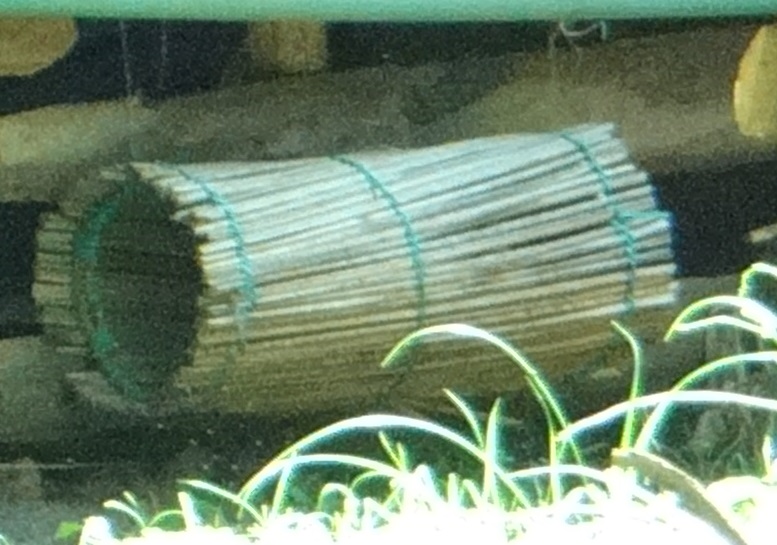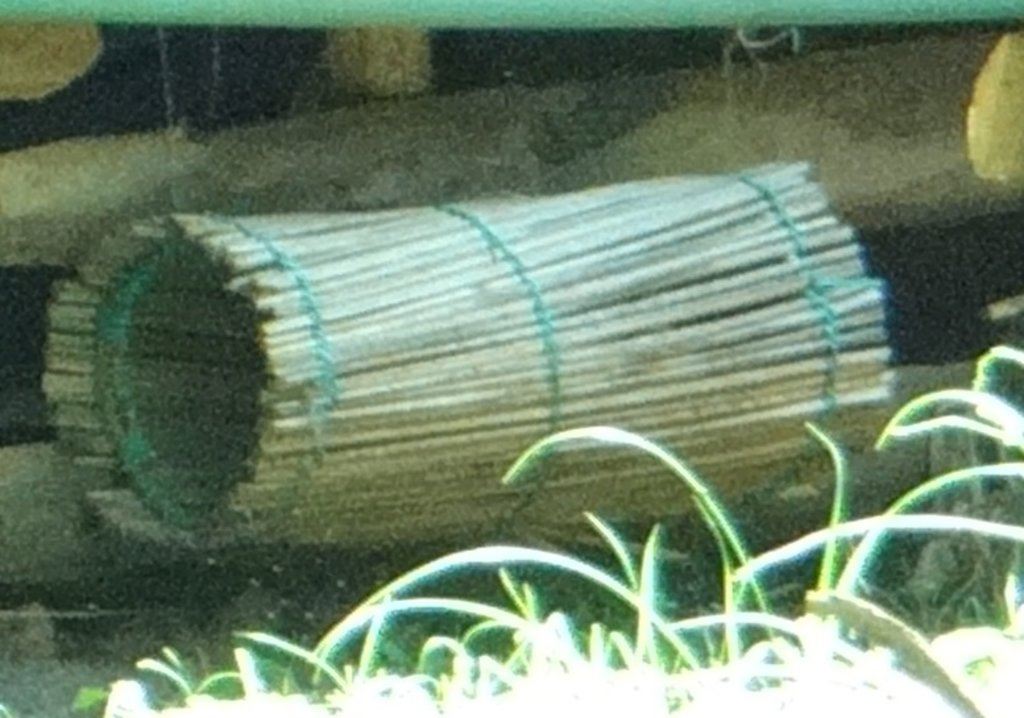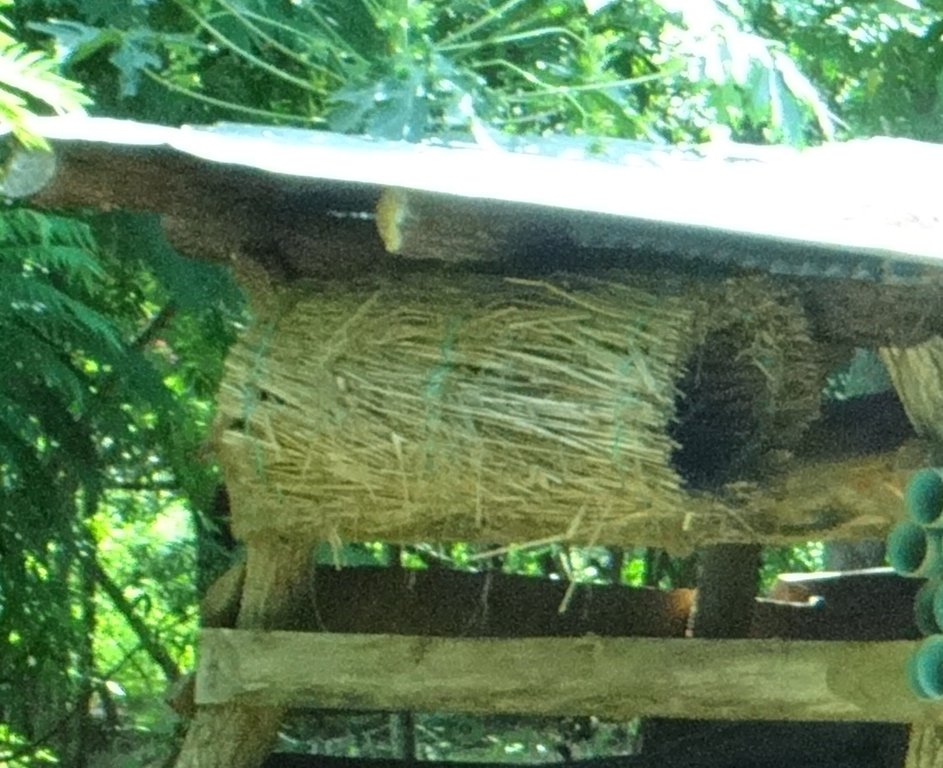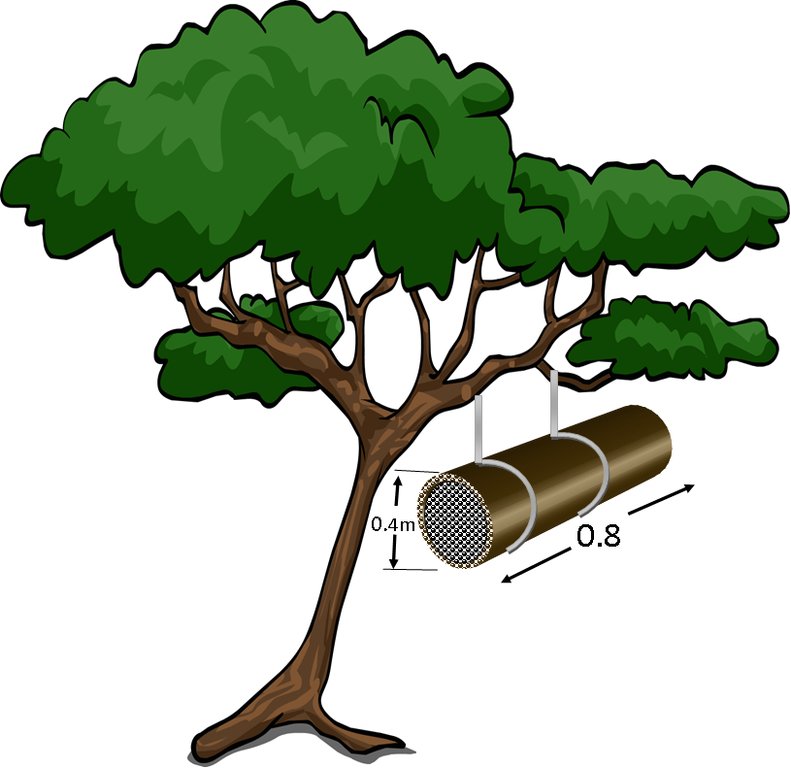Bamboo-Woven Bee Hives [乌干达]
- 创建:
- 更新:
- 编制者: Bernard Fungo
- 编辑者: JOY TUKAHIRWA, betty adoch, Kamugisha Rick Nelson, Sunday Balla Amale
- 审查者: Udo Höggel
Pito kic Ki Bong koo onyo Yen ma iye twolo
technologies_2838 - 乌干达
查看章节
全部展开 全部收起1. 一般信息
1.2 参与该技术评估和文件编制的资源人员和机构的联系方式
关键资源人
土地使用者:
Okello Samuel
Farmer
Padibe west, Lamwo District
乌干达
有助于对技术进行记录/评估的项目名称(如相关)
Scaling-up SLM practices by smallholder farmers (IFAD)有助于对技术进行记录/评估的机构名称(如相关)
Bern University of Applied Sciences, School of Agricultural, Forest and Food Sciences (HAFL) - 瑞士1.3 关于使用通过WOCAT记录的数据的条件
(现场)数据是什么时候汇编的?:
12/5/2017
编制者和关键资源人员接受有关使用通过WOCAT记录数据的条件。:
是
1.4 所述技术的可持续性声明
这里所描述的技术在土地退化方面是否存在问题,导致无法被认为是一种可持续的土地管理技术?:
否
2. SLM技术的说明
2.1 技术简介
技术定义:
Using relatively cheap and locally available bamboo material to make bee hives is adaptable to local setting and reduces harvesting of large native trees
2.2 技术的详细说明
说明:
In northern Uganda, traditional bee hives used to be made from large tree trunks chiseled into a hollow cylindrical piece of tree trunk. Owing to increased demand for more hives and due to extensive destruction of suitable trees, farmers now use locally available bamboo stems for making bee hives. This technology, apart from being a response to decreasing availability of materials such as large tree trunks that were previously used to make bee hives, it is also meant to provide a cheaper alternative to expensive modern bee hives such as the top-bar and Langstroth.
Bamboo canes are peeled into sheets of approximately 2-3 meters, and weaved in a manner similar to the way the baskets are made but in a cylindrical shape. The hives are constructed with a length varying from 0.5-0.8 m, and 0.4 m in diameter. The resulting open-ended cylinder is then covered with a grass layer of about 2 cm thick and wrapped with polythene strings to keep the grass in place. The grass is meant to insulate the hive against heat. The open ends of the cylinder are closed using a wooded circular piece of wood punched with about 10 holes of 1 cm diameter. It is through these holes that bees enter the hive. The completed hives are hung into a tree, where the bees colonize and produce honey. The hive should face north or south to protect it from the direction of sun and rain. The sun heat melts the honey comb from which honey is extracted.
The apiary should be free from termites, birds, and hygiene should be fully maintained. The hives may also be hung on two poles attached by wires that are used to hang them. These poles should be greased to avoid being damaged by termites, bush fire and red ants. The apiary should be 30 m away from the main road, flowering plants and also near water source within 100 m is recommended.
An apiary with bamboo-woven been hives conserves the natural environment and honey extracted from the honey comb generates income to the farmer. Shades must be provided at the apiary site during dry seasons. To protect the apiary, scouting should be frequently done. Bees are harmful and the apiary occupies land from other activities like agriculture.
Farmers like this type of hive because it produces relatively clean honey compared to other systems. Furthermore, the bamboo hives last relatively longer because they are affected less by degrading insects. The low cost compared to other hives such as the top-bar or langstroth make it preferred by the bee farmers. However, there is also a high risk of fire since the hive is fitted with grass that could catch fire.
2.3 技术照片
2.4 技术视频
日期:
10/05/2017
位置:
Padibe, West Lamwo Distict
2.5 已应用该技术的、本评估所涵盖的国家/地区/地点
国家:
乌干达
区域/州/省:
Northern
有关地点的进一步说明:
Ayom Village, Abakadyak Parish
Map
×2.6 实施日期
注明实施年份:
2009
2.7 技术介绍
详细说明该技术是如何引入的:
- 通过土地使用者的创新
3. SLM技术的分类
3.1 该技术的主要目的
- 减少、预防、恢复土地退化
- 保护生态系统
- 保持/提高生物多样性
- 创造有益的经济影响
3.2 应用该技术的当前土地利用类型

森林/林地
(半天然)天然森林/林地:
- 选伐
产品和服务:
- 木材
- 薪材
- 水果和坚果
- 放牧/啃牧
- 自然保持/保护
3.3 有关土地利用的更多信息
该技术所应用土地的供水:
- 雨养
注释:
The technology uses limited rainwater, since the bees can move long distances looking for water
每年的生长季节数:
- 2
具体说明:
In most cases during any dry spell which can take more than three weeks
3.4 该技术所属的SLM组
- 天然和半天然森林管理
- 防风林/防护林带
- 养蜂、养殖业、家禽业、养兔业、养蚕业等
3.5 技术传播
具体说明该技术的分布:
- 适用于特定场所/集中在较小区域
注释:
Spreading of the technology depends on the presence of trees
3.6 包含该技术的可持续土地管理措施

结构措施
- S9:动植物庇护所
- S11:其它

管理措施
- M3:根据自然和人文环境进行布局
- M5:物种组成的控制/变化
注释:
This is an integrated approach on the natural trees
3.7 该技术强调的主要土地退化类型

土壤水蚀
- Wt:表土流失/地表侵蚀

土壤风蚀
- Et:表土流失

物理性土壤退化
- Pu:由于其他活动而导致生物生产功能的丧失

生物性退化
- Bc:植被覆盖的减少
- Bs:质量和物种组成/多样性的下降
3.8 防止、减少或恢复土地退化
具体数量名该技术与土地退化有关的目标:
- 防止土地退化
4. 技术规范、实施活动、投入和成本
4.1 该技术的技术图纸
4.2 技术规范/技术图纸说明
Length of hive: 0.8m
Diameter: 0.4m
4.3 有关投入和成本计算的一般信息
具体说明成本和投入是如何计算的:
- 每个技术单元
指定单位:
One peace
其它/国家货币(具体说明):
Uganda shilling
注明美元与当地货币的汇率(如相关):1美元=:
3500.0
注明雇用劳工的每日平均工资成本:
5000
4.4 技术建立活动
| 活动 | 措施类型 | 时间 | |
|---|---|---|---|
| 1. | Cutting bamboo | 其它措施 | Any time but mostly during the dry season |
| 2. | Pealing | 其它措施 | Any time but mostly during the dry season |
| 3. | Weaving bee hives | 其它措施 | Any time but mostly during the dry season |
4.5 技术建立所需要的费用和投入
如果可能,按下表分列技术建立费用,并列明各项投入和每项投入的费用。如果您无法分解成本,给出建立该技术的总成本估算。:
5000.0
| 对投入进行具体说明 | 单位 | 数量 | 单位成本 | 每项投入的总成本 | 土地使用者承担的成本% | |
|---|---|---|---|---|---|---|
| 劳动力 | Harvesting bamboo canes | Manhours | 3.0 | 5000.0 | 15000.0 | 100.0 |
| 劳动力 | Pealing the bamboo canes | Manhours | 5.0 | 5000.0 | 25000.0 | 100.0 |
| 劳动力 | Weaving the been hives | Manhours | 15.0 | 5000.0 | 75000.0 | 100.0 |
| 设备 | Bamboo canes | Pieces | 30.0 | 1500.0 | 45000.0 | 100.0 |
| 设备 | Strings | Rolls | 1.0 | 6000.0 | 6000.0 | 100.0 |
| 设备 | Baits | Piece | 1.0 | 10000.0 | 10000.0 | 100.0 |
| 技术建立所需总成本 | 176000.0 | |||||
注释:
Protection from fire is done by the land user since it is in the farm
4.6 维护/经常性活动
| 活动 | 措施类型 | 时间/频率 | |
|---|---|---|---|
| 1. | Slashing around the beehives | 管理 | During the dry season |
注释:
Most maintenance activities were done during the dry season
4.7 维护/经常性活动所需要的费用和投入(每年)
如果可能,按下表分解技术维护费用,并列明各项投入和每项投入的费用。如果您无法分解成本,给出维护该技术的总成本估算。:
1.0
| 对投入进行具体说明 | 单位 | 数量 | 单位成本 | 每项投入的总成本 | 土地使用者承担的成本% | |
|---|---|---|---|---|---|---|
| 劳动力 | Slashing | Area (acres) | 1.0 | 30000.0 | 30000.0 | 100.0 |
| 技术维护所需总成本 | 30000.0 | |||||
注释:
The technology is almost self sustaining
4.8 影响成本的最重要因素
描述影响成本的最决定性因素:
Routine visits during the dry season
5. 自然和人文环境
5.1 气候
年降雨量
- < 250毫米
- 251-500毫米
- 501-750毫米
- 751-1,000毫米
- 1,001-1,500毫米
- 1,501-2,000毫米
- 2,001-3,000毫米
- 3,001-4,000毫米
- > 4,000毫米
农业气候带
- 半湿润
5.2 地形
平均坡度:
- 水平(0-2%)
- 缓降(3-5%)
- 平缓(6-10%)
- 滚坡(11-15%)
- 崎岖(16-30%)
- 陡峭(31-60%)
- 非常陡峭(>60%)
地形:
- 高原/平原
- 山脊
- 山坡
- 山地斜坡
- 麓坡
- 谷底
垂直分布带:
- 0-100 m a.s.l.
- 101-500 m a.s.l.
- 501-1,000 m a.s.l.
- 1,001-1,500 m a.s.l.
- 1,501-2,000 m a.s.l.
- 2,001-2,500 m a.s.l.
- 2,501-3,000 m a.s.l.
- 3,001-4,000 m a.s.l.
- > 4,000 m a.s.l.
说明该技术是否专门应用于:
- 不相关
5.3 土壤
平均土层深度:
- 非常浅(0-20厘米)
- 浅(21-50厘米)
- 中等深度(51-80厘米)
- 深(81-120厘米)
- 非常深(> 120厘米)
土壤质地(表土):
- 中粒(壤土、粉土)
土壤质地(地表以下> 20厘米):
- 中粒(壤土、粉土)
表土有机质:
- 中(1-3%)
如有可能,附上完整的土壤描述或具体说明可用的信息,例如土壤类型、土壤酸碱度、阳离子交换能力、氮、盐度等。:
The soil is not a basic requirement for the technology
5.4 水资源可用性和质量
地下水位表:
5-50米
地表水的可用性:
好
水质(未处理):
良好饮用水
水的盐度有问题吗?:
否
该区域正在发生洪水吗?:
否
关于水质和水量的注释和进一步规范:
Water is also used for drinking, especially from protected sites
5.5 生物多样性
物种多样性:
- 中等
栖息地多样性:
- 中等
关于生物多样性的注释和进一步规范:
It is a mixed crop farm with protected water source
5.6 应用该技术的土地使用者的特征
定栖或游牧:
- 定栖的
生产系统的市场定位:
- 混合(生计/商业
非农收入:
- 收入的10-50%
相对财富水平:
- 平均水平
个人或集体:
- 个人/家庭
机械化水平:
- 畜力牵引
性别:
- 男人
土地使用者的年龄:
- 中年人
说明土地使用者的其他有关特征:
The land user is educated
5.7 应用该技术的土地使用者拥有或租用的平均土地面积
- < 0.5 公顷
- 0.5-1 公顷
- 1-2 公顷
- 2-5公顷
- 5-15公顷
- 15-50公顷
- 50-100公顷
- 100-500公顷
- 500-1,000公顷
- 1,000-10,000公顷
- > 10,000公顷
这被认为是小规模、中规模还是大规模的(参照当地实际情况)?:
- 中等规模的
5.8 土地所有权、土地使用权和水使用权
土地所有权:
- 个人,未命名
土地使用权:
- 个人
用水权:
- 个人
5.9 进入服务和基础设施的通道
健康:
- 贫瘠
- 适度的
- 好
教育:
- 贫瘠
- 适度的
- 好
技术援助:
- 贫瘠
- 适度的
- 好
就业(例如非农):
- 贫瘠
- 适度的
- 好
市场:
- 贫瘠
- 适度的
- 好
能源:
- 贫瘠
- 适度的
- 好
道路和交通:
- 贫瘠
- 适度的
- 好
饮用水和卫生设施:
- 贫瘠
- 适度的
- 好
金融服务:
- 贫瘠
- 适度的
- 好
6. 影响和结论性说明
6.1 该技术的现场影响
社会经济效应
生产
作物生产
注释/具体说明:
Improve pollination of crop flowers leads to improved yields
作物质量
注释/具体说明:
Presence of bees in farm also deters other harmful insects that destroy crops or transmit crop pests and diseases
畜牧生产
注释/具体说明:
As a livestock, it results into more honey produced
生产故障风险
注释/具体说明:
Bees easily colonize hives made of locally available bambo or stake materials within their environment
土地管理
注释/具体说明:
This approach ensures integrated land management
收入和成本
农业投入费用
注释/具体说明:
Cost of buying a hive is not incurred
农业收入
注释/具体说明:
High yield of honey gives more income to the farmer
收入来源的多样性
注释/具体说明:
Both from crops, animals and honey.
工作量
注释/具体说明:
Easy to manage the bees since there is little need to put baits
社会文化影响
食品安全/自给自足
注释/具体说明:
Farmers harvest adequate honey which is also rich in nutrients
健康状况
注释/具体说明:
Honey contain high nutrient content and also acts as antibiotics against some infections
社区机构
注释/具体说明:
Through marketing of the bee products in farmer groups
SLM/土地退化知识
注释/具体说明:
Farmers learn how to utilize locally available materials to make hives. e.g bamboo, ropes
冲突缓解
注释/具体说明:
In areas near national parks, bee keeping reduces human wildlife conflicts because bees repel away wild animals from reaching the farm stead
生态影响
生物多样性:植被、动物
植物多样性
注释/具体说明:
Pollination by bees improves plant diversity
外来入侵物种
注释/具体说明:
Bees repel away some invasive insects from the environment
有益物种
注释/具体说明:
Increase in bees as social insects
栖息地多样性
注释/具体说明:
The habitat become more diverse and plant species increase
害虫/疾病控制
注释/具体说明:
Bees repel away some pests which infest crops or spread crop diseases
减少气候和灾害风险
微气候
注释/具体说明:
Increase in plant diversity because of the presence of bees create a bio-diverse micro climate
6.3 技术对渐变气候以及与气候相关的极端情况/灾害的暴露和敏感性(土地使用者认为的极端情况/灾害)
渐变气候
渐变气候
| 季节 | 气候变化/极端天气的类型 | 该技术是如何应对的? | |
|---|---|---|---|
| 季节性温度 | 旱季 | 增加 | 适度 |
气候有关的极端情况(灾害)
生物灾害
| 该技术是如何应对的? | |
|---|---|
| 流行病 | 不好 |
6.4 成本效益分析
技术收益与技术建立成本相比如何(从土地使用者的角度看)?
短期回报:
积极
长期回报:
非常积极
技术收益与技术维护成本/经常性成本相比如何(从土地使用者的角度看)?
短期回报:
积极
长期回报:
非常积极
注释:
The benefits increase with time due the number of products and the colonization of the hives
6.5 技术采用
- 1-10%
在所有采用这项技术的人当中,有多少人是自发地采用该技术,即未获得任何物质奖励/付款?:
- 90-100%
注释:
This technology is traditional and farmers who keep bees learn them from others within the community
6.6 适应
最近是否对该技术进行了修改以适应不断变化的条件?:
否
6.7 该技术的优点/长处/机会
| 土地使用者眼中的长处/优势/机会 |
|---|
| Easy to manage |
| No additional cost after establishment |
| 编制者或其他关键资源人员认为的长处/优势/机会 |
|---|
| It is highly sustainable |
6.8 技术的弱点/缺点/风险及其克服方法
| 土地使用者认为的弱点/缺点/风险 | 如何克服它们? |
|---|---|
| Fire | Early clearing |
| Its a medium term investment | Constant replacement |
| 编制者或其他关键资源人员认为的弱点/缺点/风险 | 如何克服它们? |
|---|---|
| Sometimes the hives may not be colonized | Continuously checking |
7. 参考和链接
7.1 信息的方法/来源
- 实地考察、实地调查
2
- 与土地使用者的访谈
1
链接和模块
全部展开 全部收起链接
无链接
模块
无模块






